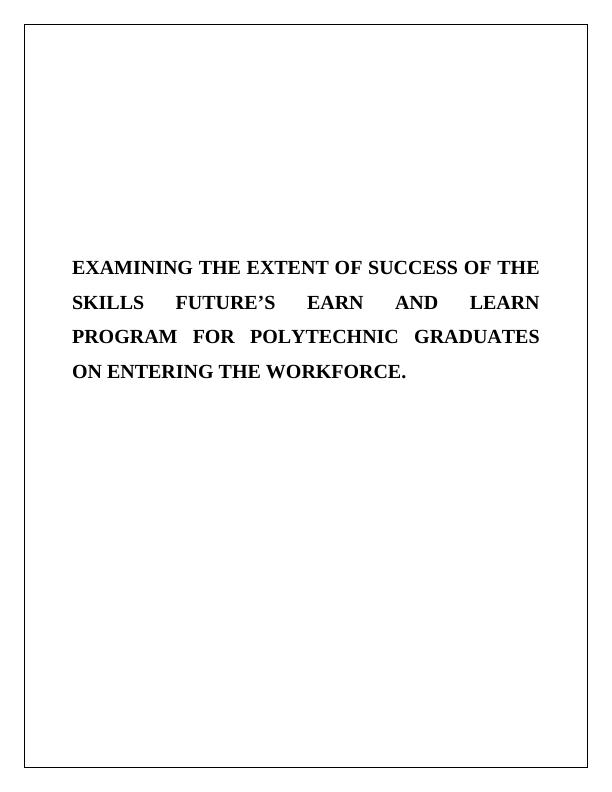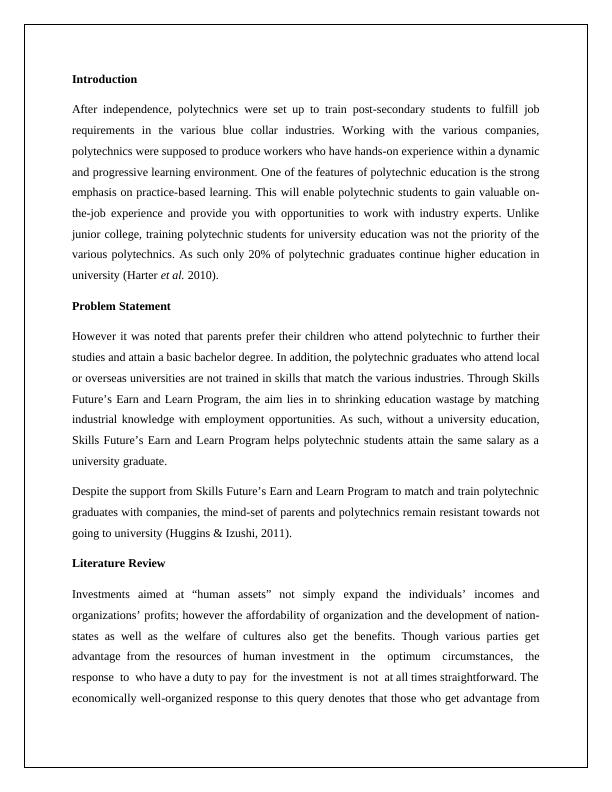Examining the Success of Skills Future's Earn and Learn Program for Polytechnic Graduates
Added on 2023-01-13
15 Pages4151 Words64 Views
EXAMINING THE EXTENT OF SUCCESS OF THE
SKILLS FUTURE’S EARN AND LEARN
PROGRAM FOR POLYTECHNIC GRADUATES
ON ENTERING THE WORKFORCE.
SKILLS FUTURE’S EARN AND LEARN
PROGRAM FOR POLYTECHNIC GRADUATES
ON ENTERING THE WORKFORCE.

Introduction
After independence, polytechnics were set up to train post-secondary students to fulfill job
requirements in the various blue collar industries. Working with the various companies,
polytechnics were supposed to produce workers who have hands-on experience within a dynamic
and progressive learning environment. One of the features of polytechnic education is the strong
emphasis on practice-based learning. This will enable polytechnic students to gain valuable on-
the-job experience and provide you with opportunities to work with industry experts. Unlike
junior college, training polytechnic students for university education was not the priority of the
various polytechnics. As such only 20% of polytechnic graduates continue higher education in
university (Harter et al. 2010).
Problem Statement
However it was noted that parents prefer their children who attend polytechnic to further their
studies and attain a basic bachelor degree. In addition, the polytechnic graduates who attend local
or overseas universities are not trained in skills that match the various industries. Through Skills
Future’s Earn and Learn Program, the aim lies in to shrinking education wastage by matching
industrial knowledge with employment opportunities. As such, without a university education,
Skills Future’s Earn and Learn Program helps polytechnic students attain the same salary as a
university graduate.
Despite the support from Skills Future’s Earn and Learn Program to match and train polytechnic
graduates with companies, the mind-set of parents and polytechnics remain resistant towards not
going to university (Huggins & Izushi, 2011).
Literature Review
Investments aimed at “human assets” not simply expand the individuals’ incomes and
organizations’ profits; however the affordability of organization and the development of nation-
states as well as the welfare of cultures also get the benefits. Though various parties get
advantage from the resources of human investment in the optimum circumstances, the
response to who have a duty to pay for the investment is not at all times straightforward. The
economically well-organized response to this query denotes that those who get advantage from
After independence, polytechnics were set up to train post-secondary students to fulfill job
requirements in the various blue collar industries. Working with the various companies,
polytechnics were supposed to produce workers who have hands-on experience within a dynamic
and progressive learning environment. One of the features of polytechnic education is the strong
emphasis on practice-based learning. This will enable polytechnic students to gain valuable on-
the-job experience and provide you with opportunities to work with industry experts. Unlike
junior college, training polytechnic students for university education was not the priority of the
various polytechnics. As such only 20% of polytechnic graduates continue higher education in
university (Harter et al. 2010).
Problem Statement
However it was noted that parents prefer their children who attend polytechnic to further their
studies and attain a basic bachelor degree. In addition, the polytechnic graduates who attend local
or overseas universities are not trained in skills that match the various industries. Through Skills
Future’s Earn and Learn Program, the aim lies in to shrinking education wastage by matching
industrial knowledge with employment opportunities. As such, without a university education,
Skills Future’s Earn and Learn Program helps polytechnic students attain the same salary as a
university graduate.
Despite the support from Skills Future’s Earn and Learn Program to match and train polytechnic
graduates with companies, the mind-set of parents and polytechnics remain resistant towards not
going to university (Huggins & Izushi, 2011).
Literature Review
Investments aimed at “human assets” not simply expand the individuals’ incomes and
organizations’ profits; however the affordability of organization and the development of nation-
states as well as the welfare of cultures also get the benefits. Though various parties get
advantage from the resources of human investment in the optimum circumstances, the
response to who have a duty to pay for the investment is not at all times straightforward. The
economically well-organized response to this query denotes that those who get advantage from

the undertaking of project must pay the expenses of learning and training (Ashill et al. 2019).
Nevertheless, it may not each time be clear who will get aid from investments in human
wealth since this sort of funds can generate constructive externalities (profits to entities or
persons who did not capitalize) or support to inhibit negative externalities (rates of non-
education- that get lifted to others).
In the setting of company-offered training, the conventional human capital theory propounded
by Becker specifies that—in economic labor marketplaces—staffs have a duty to support all
expenses of investments in overall human wealth. For organization-specific human resources,
proprietors and workforces must share the dealing expenditures. All-purpose human capital
remains demarcated as all talents and awareness that a member of staff can utilize across
numerous companies, while firm-specific “human wealth” refer to knowledge and abilities
which are not transportable from the prevailing proprietor to other organizations (Ghapanchi et
al. 2014).
Yet, experiential interpretations display that companies invest fairly and recurrently in
wide-ranging human capital. Subsequently this denies the concept, concerns of the principle are
essential to enhance and agree to proceed as per the legitimate settings. During 1970s there
pursued numerous such allowances of the innovative theoretical ideals. Mostly, yet not entirely,
in some approach or another, the postulation was relaxed that labor marketplaces stand as
competitive. If employment marketplaces have resistances, then these abrasions permit the firms
to capitalize in their workers’ all-purpose human wealth without exposing downfall of the asset.
They can recover the cost later by compensating remunerations under employees’ peripheral
throughput. Apart from that, companies that capitalize in training can protect currency even
in inexpensive labor markets by decreasing incomes or else by indicating healthier working
situations and in that way tempting more gifted and motivated candidates (Harter et al. 2010).
Nevertheless, it may not each time be clear who will get aid from investments in human
wealth since this sort of funds can generate constructive externalities (profits to entities or
persons who did not capitalize) or support to inhibit negative externalities (rates of non-
education- that get lifted to others).
In the setting of company-offered training, the conventional human capital theory propounded
by Becker specifies that—in economic labor marketplaces—staffs have a duty to support all
expenses of investments in overall human wealth. For organization-specific human resources,
proprietors and workforces must share the dealing expenditures. All-purpose human capital
remains demarcated as all talents and awareness that a member of staff can utilize across
numerous companies, while firm-specific “human wealth” refer to knowledge and abilities
which are not transportable from the prevailing proprietor to other organizations (Ghapanchi et
al. 2014).
Yet, experiential interpretations display that companies invest fairly and recurrently in
wide-ranging human capital. Subsequently this denies the concept, concerns of the principle are
essential to enhance and agree to proceed as per the legitimate settings. During 1970s there
pursued numerous such allowances of the innovative theoretical ideals. Mostly, yet not entirely,
in some approach or another, the postulation was relaxed that labor marketplaces stand as
competitive. If employment marketplaces have resistances, then these abrasions permit the firms
to capitalize in their workers’ all-purpose human wealth without exposing downfall of the asset.
They can recover the cost later by compensating remunerations under employees’ peripheral
throughput. Apart from that, companies that capitalize in training can protect currency even
in inexpensive labor markets by decreasing incomes or else by indicating healthier working
situations and in that way tempting more gifted and motivated candidates (Harter et al. 2010).

Figure: ELP Education scheme
(Source: Skills Future, 2018)
Time and again, however, resistances of labor marketplace originate with a charge, for
illustration, higher intensities of redundancy, besides every businesses cannot relish the
equivalent extent of teaching investment security from industrial market frictions (Kotler,
2012) Consequently, with the intention of enlightening modifications in the prevalence of
physical activities, distribution among nations, economic divisions or singular corporations, the
emphasis has lately re-shifted towards the query of the environments wherein or series of which
establishments can deliver overall human wealth without going into disposable costs. These
enquiries denote specific solicitation in labor markets which come near to a cost-effective
service market otherwise designed for SMEs. Small companies are further approaching to miss
their members after teaching than big companies who can deal with inner labor markets.
Consequently, SMEs need to depend on the industrious assistances of applicants throughout the
teaching period to include their training expenses (Lancaster, 2012)
Differentiation Overall Cost
(Source: Skills Future, 2018)
Time and again, however, resistances of labor marketplace originate with a charge, for
illustration, higher intensities of redundancy, besides every businesses cannot relish the
equivalent extent of teaching investment security from industrial market frictions (Kotler,
2012) Consequently, with the intention of enlightening modifications in the prevalence of
physical activities, distribution among nations, economic divisions or singular corporations, the
emphasis has lately re-shifted towards the query of the environments wherein or series of which
establishments can deliver overall human wealth without going into disposable costs. These
enquiries denote specific solicitation in labor markets which come near to a cost-effective
service market otherwise designed for SMEs. Small companies are further approaching to miss
their members after teaching than big companies who can deal with inner labor markets.
Consequently, SMEs need to depend on the industrious assistances of applicants throughout the
teaching period to include their training expenses (Lancaster, 2012)
Differentiation Overall Cost

End of preview
Want to access all the pages? Upload your documents or become a member.
Related Documents
Polytechnic Work Based Learning Studylg...
|19
|4263
|116
Innovation and Technology Assignmentlg...
|4
|1072
|314
Resourcing and Talent Planning: Government Strategies, Employee Skills, and Employer Contributionslg...
|18
|4650
|180
Importance of Skilled Workforce in Contemporary People Managementlg...
|7
|2070
|381
Strengths Enrich Power Point Presentation 2022lg...
|4
|1172
|47
HR 0275 Personal and Organisational Developmentlg...
|14
|4011
|54